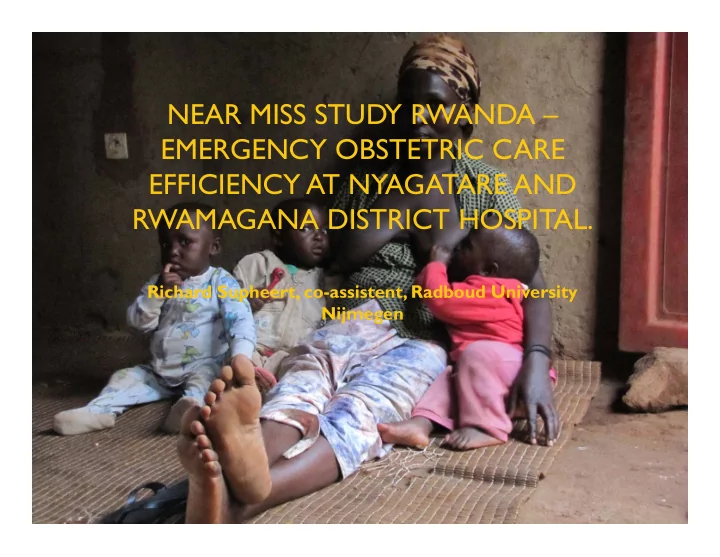

NEAR MISS STUDY RWANDA – EMERGENCY OBSTETRIC CARE EFFICIENCY AT NYAGATARE AND RWAMAGANA DISTRICT HOSPITAL. Richard Supheert, co-assistent, Radboud University Nijmegen
NEAR MISS CASES ‘Women who almost died due to medical complications during pregnancy, giving birth or within 42 days after termination of pregnancy.’
A TYPICAL MATERNITY DEPT AT DISTRICT HOSPITALS 11 deliveries per day on average, 3 C-sections No obstetricians, only midwifes and 1 post-graduate doctor Several uterine ruptures per week Several fetal deaths per week No knowledge about adequate resuscitation on newborns No sterile environment or equipment to conduct a C-section Not enough beds: ‘Floor beds’ No health insurance: €4,- per year Low intrinsic motivation health workers INTRODUCTION - METHODS - RESULTS - CONCLUSIONS
RESEARCH QUESTION What is the difference in the management of emergency obstetric cases between near miss cases and women who delivered safely in November 2015 in the Nyagatare and Rwamagana district hospitals in Rwanda? INTRODUCTION - METHODS - RESULTS - CONCLUSIONS
WORKING IN 2 DISTRICT HOSPITALS Coverage indicators Process indicators Outcome indicators T wo district hospitals included in this study: Rwamagana district hospital: Nyagatare district hospital: - Good coverage indicators - Poor coverage indicators - Poor process indicators - Good process indicators - Poor outcome indicators - Poor outcome indicators INTRODUCTION - METHODS - RESULTS - CONCLUSIONS
PROSPECTIVE EXPLORATIVE CASE- CONTROL STUDY (PILOT STUDY) Haydom near miss criteria Haydom criteria Clinical criteria For every near miss case, two controls Acute cyanosis Gasping A questionnaire was filled for every Repiratory rate >40 or < 6/min. Shock identified near miss event and control Oliguria non responsive to fluids or diuretics Failure to form clots Loss of consciousness lasting > 12 h Controls were matched by age, parity, Cardiac arrest Stroke mode of delivery and time of delivery Uncontrollable fit/total paralysis Jaundice in the presence of pre ‐ eclampsia Laboratory ‐ based criteria Oxygen saturation < 90% for ≥ 60 minutes Acute thrombocytopenia (<50,000 platelets/ml) Management ‐ based criteria Admission to intensive care unit Hysterectomy following infection or haemorrhage Transfusion of ≥ 1 unit of blood Intubation and ventilation for ≥ 60 minutes not related to anaesthesia Cardio ‐ pulmonary resuscitation Severe maternal complications Eclampsia Sepsis or severe systemic infection Uterine rupture INTRODUCTION - METHODS – RESULTS - CONCLUSIONS
NUMBER OF WOMEN INCLUDED Nyagatare: 326 deliveries, November 2015 24 near miss cases T otal: 46 controls 30 near miss cases 56 controls Rwamagana: 254 deliveries, November 2015 6 near miss cases PILOT study Felix Sayinzoga (MD), Dr. Leon Bijlmakers, 12 controls Prof. Koos van der Velden, 4 districts, 215 NM cases, 400 controls (to be published) INTRODUCTION - METHODS – RESULTS - CONCLUSIONS
RESULTS Near miss cases versus controls High cesarean section rate (WHO 10-15% recommended on a population level) In 25% of all near miss cases in Nyagatare DH a laparotomy was necessary (uterine rupture) INTRODUCTION - METHODS - RESULTS - CONCLUSIONS
DISTRIBUTION OF COMPLICATIONS Largest group: Hemorrhage 18% Hemorrhage (APH, IPH, PPH) (38%) 38% Pre-eclampsia 12% Eclampsia Included using Sepsis or sever systemic infection the Haydom Ruptured uterus criteria 17% Dysfunctional blood clotting 12% 3% Distribution of medical complications among near miss cases from Nyagatare and Rwamagana district hospital (N=30) INTRODUCTION - METHODS – RESULTS - CONCLUSIONS
CASE MANAGEMENT – BLOOD PLATELETS Dysfunctional blood clotting group: 18% 18% Hemorrhage (APH, IPH, PPH) Pre-eclampsia 18% of all near miss 38% Eclampsia cases had a low blood Sepsis or sever systemic infection 12% platelet level Ruptured uterus Dysfunctional blood clotting Invasive treatment or C- section before 17% correction of blood 12% 3% platelets Distribution of medical complications among near Nyagatare: 2 hour one- miss cases from Nyagatare and Rwamagana district way drive to nearest hospital (N=30) bloodbank INTRODUCTION - METHODS - RESULTS - CONCLUSIONS
CASE MANAGEMENT – FETAL DEATH Of the 12 fetal deaths recorded, 11 deaths were in Nyagatare DH Much lower percentage of fetal deaths among the control group INTRODUCTION - METHODS - RESULTS - CONCLUSIONS
CASE MANAGEMENT – TRANSPORT Overall duration of transport is several hours (up till 10 hours) T endency of the control group having a longer time of transport INTRODUCTION - METHODS - RESULTS - CONCLUSIONS
PREVENTION: ANTE NATAL CARE CHECK-UPS The WHO recommends a minimum of 4 ante natal care check-ups No significant difference between the near miss group and control group was found (P = 0,565) INTRODUCTION - METHODS - RESULTS - CONCLUSIONS
THE EDUCATIONAL GAP T endency of women in the control group being higher educated than women in the near miss group No significant difference was found (P = 0,122) INTRODUCTION - METHODS - RESULTS - CONCLUSIONS
HEALTH INSURANCE: THE MUTUELLE DE SANTÉ 10% of near miss cases has no medical insurance Rwandan Social Security Board (RSSB) gives better coverage than the Mutuelle INTRODUCTION - METHODS - RESULTS - CONCLUSIONS
CONCLUSIONS Medical complications Antenatal care and Cesarean section rates too high management of Dysfunctional blood clotting women in labour Number of ante natal care check-ups too low leave room for Emergency transportation time too long improvement, The educational gap especially at one of No medical health insurance the two hospitals. Medical skills and knowledge not up to date Low intrinsic motivation to improve INTRODUCTION - METHODS - RESULTS - CONCLUSIONS
ACHIEVING LEARNING GOALS; GET YOUR EXPOSURE. Serious medical cases Patients seek for help too late, no equipment Maternal and fetal death, no money for the mortuary Cardboard boxes
Questions? Stay in touch? richard_supheert@hotmail.com ‘We are all confronted with a bunch of great possibilities, beautifully disguised as unsolvable problems.’ (John W. Gardner)
Recommend
More recommend